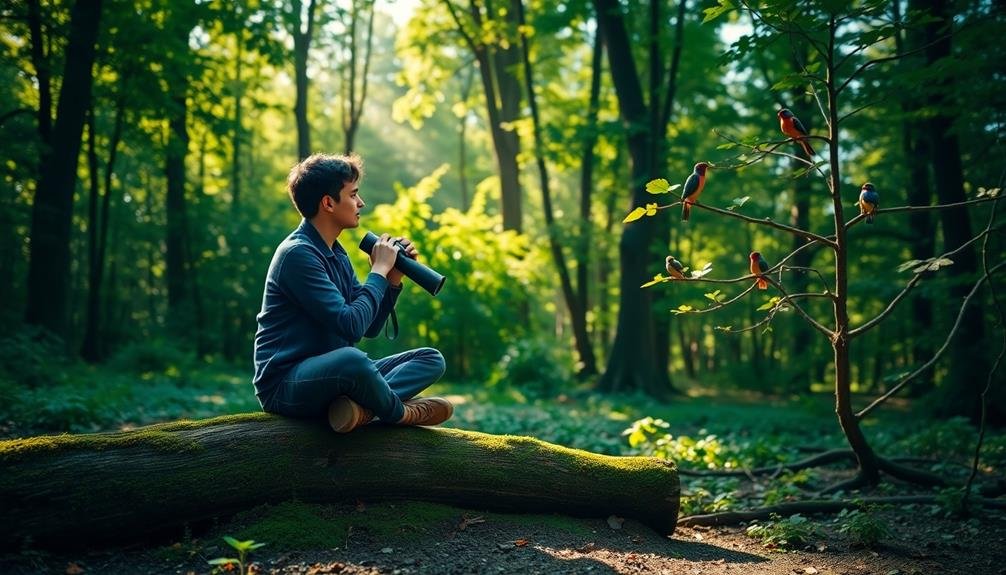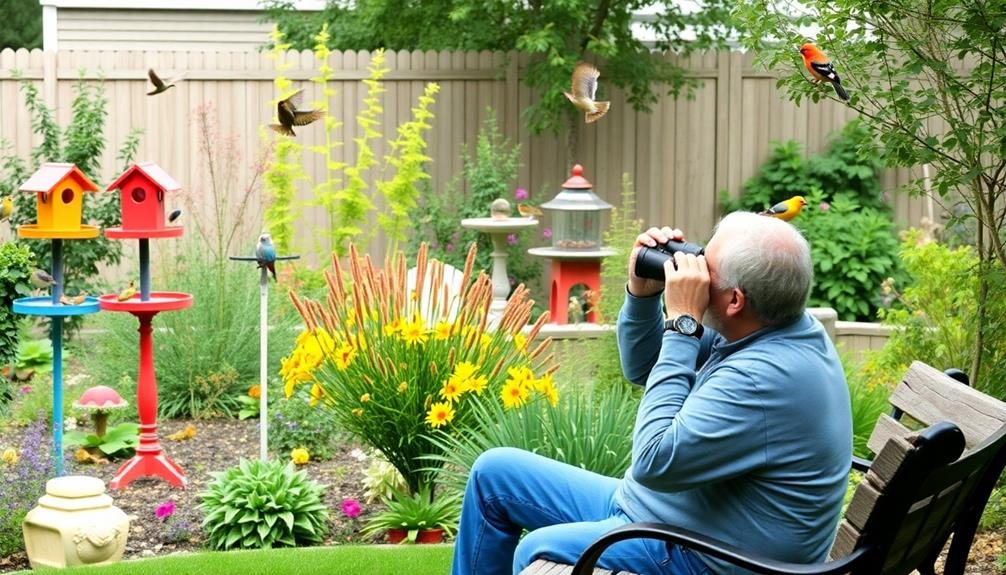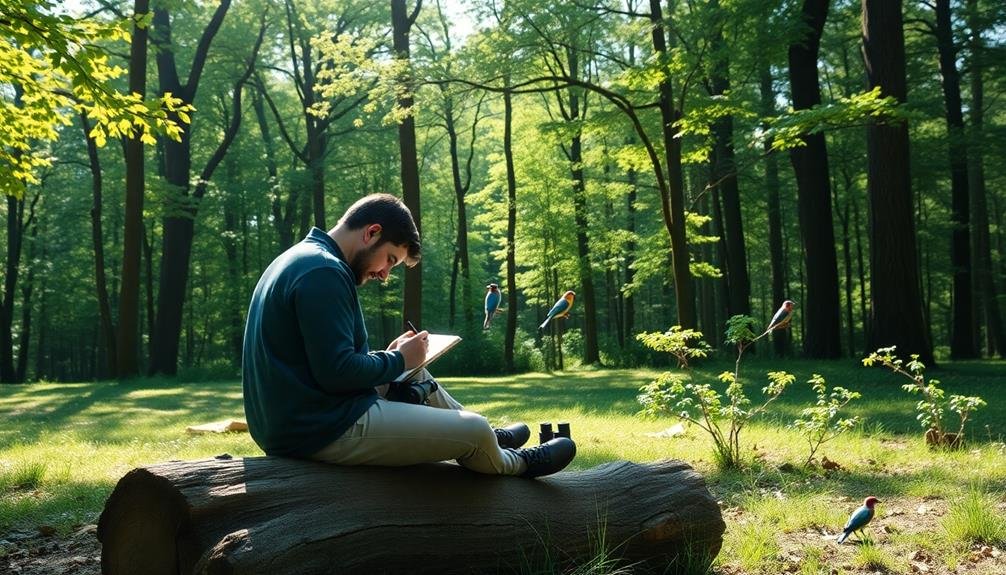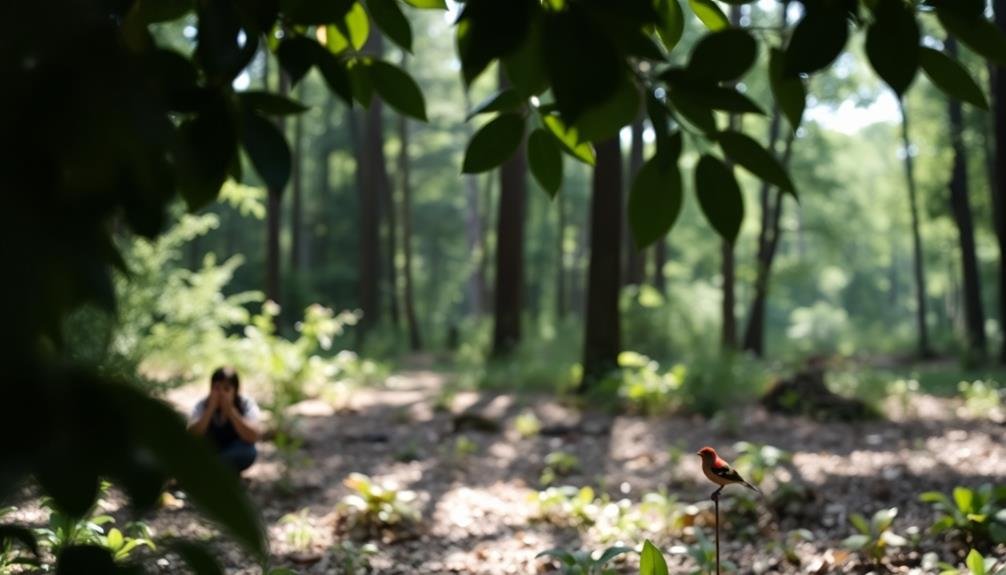Bird watching offers several effective methods to reduce anxiety. You can practice mindful observation, focusing on being fully present while engaging all your senses. Try slow-paced birding walks, either solo or in small groups, to enhance relaxation. Create a backyard bird sanctuary to attract diverse species and provide a peaceful observation spot. Engage in bird song meditation techniques to calm your mind. Nature journaling can help you document your experiences and increase appreciation. Quiet group excursions foster camaraderie while maintaining a serene atmosphere. Bird photography allows you to capture beautiful moments and relive peaceful experiences. These methods combine nature's soothing power with mindfulness, offering a wealth of anxiety-reducing benefits to explore.
Mindful Bird Watching Practices

One of the most effective ways to reduce anxiety through bird watching is to practice mindfulness. As you observe birds, focus on being fully present in the moment.
Start by finding a comfortable spot outdoors, whether it's a park bench or your backyard. Take deep breaths and consciously relax your body. Engage all your senses: listen for bird calls, watch for movement, and feel the breeze on your skin.
When you spot a bird, resist the urge to immediately identify it. Instead, observe its behavior, colors, and movements without judgment. Notice how it interacts with its environment. If your mind wanders, gently bring your attention back to the bird. This practice helps quiet racing thoughts and grounds you in the present.
Try incorporating mindful breathing exercises while bird watching. Synchronize your breath with the bird's movements or use the rhythm of bird calls as a focus point.
You can also practice gratitude by appreciating the beauty and diversity of the birds you encounter. These mindful practices can greatly reduce anxiety by shifting your focus away from worries and onto the natural world around you.
Slow-Paced Birding Walks
Slow-paced birding walks offer you a chance to practice mindful observation techniques while immersing yourself in nature.
You'll find specially designed routes that maximize bird sightings and minimize distractions.
Whether you prefer solo outings for personal reflection or group walks for shared experiences, these leisurely strolls can greatly enhance your bird watching and anxiety-reduction journey.
Mindful Observation Techniques
When you're feeling overwhelmed, a mindful birding walk can be a powerful antidote to anxiety. As you step outside, take a moment to ground yourself in the present. Focus on your breath, inhaling deeply and exhaling slowly.
Now, engage your senses fully in the birding experience. Listen intently for bird calls, trying to pinpoint their direction and distinguish between different species. Don't rush to identify every sound; instead, appreciate the complexity and variety of nature's orchestra.
As you spot a bird, observe it closely without judgment. Notice its colors, movements, and behavior. How does it interact with its environment?
Use your binoculars mindfully, feeling their weight and adjusting the focus deliberately. This process can help anchor you in the present moment.
As you watch, practice describing the bird to yourself in detail, as if you're explaining it to someone else. This exercise sharpens your attention and deepens your connection with nature.
Nature-Immersive Walking Routes
Numerous nature-immersive walking routes can transform your birding experience into a powerful anxiety-reducing activity. These slow-paced walks allow you to fully engage with your surroundings, focusing on the sights, sounds, and sensations of nature.
Start by researching local parks, nature reserves, or wildlife sanctuaries that offer well-maintained trails suitable for birding. Choose routes that feature diverse habitats, such as forests, wetlands, or meadows, to increase your chances of spotting various bird species.
As you walk, maintain a gentle pace and breathe deeply, allowing yourself to become fully present in the moment. Pay attention to the rustling of leaves, the chirping of birds, and the feel of the ground beneath your feet.
Consider creating a personal "birding circuit" of favorite routes that you can rotate through regularly. This familiarity can provide comfort while still offering new discoveries with each visit.
Don't forget to bring essentials like binoculars, a field guide, and comfortable shoes. By immersing yourself in nature through these carefully planned walks, you'll likely find your anxiety levels decreasing as you connect with the natural world around you.
Solo vs. Group Outings
While nature-immersive walking routes offer a great foundation for anxiety-reducing birding, you'll need to decide whether to commence on these journeys alone or with others.
Solo outings provide a sense of solitude and personal reflection, allowing you to move at your own pace and fully immerse yourself in the experience. You'll have the freedom to stop and observe birds without feeling rushed or distracted by others.
On the other hand, group outings offer social interaction and shared experiences, which can be beneficial for those who find comfort in companionship. You'll have the opportunity to learn from more experienced birders and share your own knowledge.
Group dynamics can also add an element of excitement and motivation to your birding walks.
Consider alternating between solo and group outings to reap the benefits of both approaches. Solo walks allow for introspection and personal growth, while group outings provide social support and shared enthusiasm.
Ultimately, choose the method that best aligns with your comfort level and anxiety-reduction goals. Remember, the key is to find a balance that enhances your birding experience while effectively managing your anxiety.
Backyard Bird Sanctuary Creation

Creating a backyard bird sanctuary can greatly enhance your bird-watching experience and reduce anxiety.
You'll want to focus on attracting diverse bird species by providing various food sources, water features, and nesting areas.
Designate peaceful observation spots within your yard, such as a comfortable seating area or a sheltered viewing nook, where you can quietly observe and connect with nature.
Attract Diverse Bird Species
Transforming your backyard into a bird sanctuary can greatly boost the diversity of species you'll attract. To increase variety, offer different types of food sources. Install multiple feeders with various seed mixes, suet cakes, and nectar for hummingbirds.
Don't forget to provide fresh water through birdbaths or small fountains, which will draw in species that mightn't visit feeders.
Create diverse habitats by planting native trees, shrubs, and flowers. These will provide natural food sources, nesting sites, and shelter for different bird species. Include a mix of evergreen and deciduous plants to guarantee year-round cover.
Add brush piles or leave fallen leaves in some areas to attract ground-feeding birds.
Consider vertical diversity by incorporating different heights in your garden design. This will appeal to birds that prefer various levels for feeding and nesting.
Install birdhouses of different sizes and styles to accommodate various species' preferences.
Finally, minimize the use of pesticides to maintain a healthy insect population, which serves as a vital food source for many birds.
Create Peaceful Observation Spots
A serene observation spot is vital for enjoying your backyard bird sanctuary. To create a peaceful atmosphere, consider the following elements:
- Location: Choose a quiet corner of your yard, away from noisy areas like streets or play areas. Ascertain you have a clear view of your bird feeders and baths.
- Seating: Install comfortable, weather-resistant seating that blends with the natural surroundings. A bench, chair, or even a small hammock can provide a cozy spot for extended bird watching sessions.
- Shelter: Add a small gazebo or pergola to protect you from sun and light rain. This structure can also serve as a support for climbing plants, creating a more natural environment.
- Soundscape: Incorporate gentle, natural sounds to mask any unwanted noise. A small water feature or wind chimes can enhance the peaceful ambiance.
Remember to keep your observation spot clutter-free and maintain a respectful distance from bird activity areas.
Bird Song Meditation Techniques
Several bird song meditation techniques can help you harness the calming power of avian melodies to reduce anxiety.
Start by finding a quiet spot where you can hear birds clearly. Close your eyes and focus on your breath, taking slow, deep inhales and exhales. As you breathe, tune in to the bird songs around you. Don't try to identify the species; instead, simply listen to the rhythms and patterns.
Practice "sound bathing" by imagining the bird songs washing over you, cleansing away stress and worry. You can also try "active listening," where you mentally follow a single bird's song, noting its pitch, tempo, and duration. This helps anchor your mind in the present moment.
Another technique is "bird song mimicry." Attempt to recreate the sounds you hear, either by whistling or humming. This engages your mind and body, promoting a sense of connection with nature.
For a guided experience, use bird song meditation apps or recordings that combine calming narration with natural avian sounds. Regular practice of these techniques can greatly reduce anxiety levels and improve overall well-being.
Nature Journaling for Bird Enthusiasts

Nature journaling offers bird enthusiasts a powerful tool for reducing anxiety while deepening their connection to the avian world. By combining observation, art, and reflection, you'll create a personalized record of your birding experiences. This practice encourages mindfulness and helps you slow down, focusing on the present moment rather than worrying about the future.
To start nature journaling for bird watching, follow these steps:
- Choose a journal and supplies that suit your style, such as a sketchbook, colored pencils, and a field guide.
- Find a comfortable spot outdoors and observe the birds around you, noting their behaviors, calls, and physical features.
- Sketch the birds you see, even if you're not an artist – the act of drawing helps sharpen your observation skills.
- Write down your thoughts, feelings, and any interesting facts you learn about the birds you encounter.
Don't worry about perfection; the goal is to engage with nature and document your experiences. As you develop this habit, you'll likely find that your anxiety levels decrease while your appreciation for birds and their habitats grows.
Quiet Group Birding Excursions
Serenity can be found in the shared experience of quiet group birding excursions. These outings offer a unique blend of social connection and peaceful observation, making them an excellent method for reducing anxiety. You'll find comfort in the company of like-minded individuals who share your passion for birds and nature.
When participating in a quiet group birding excursion, you'll learn to move slowly and deliberately, focusing on your surroundings rather than your worries. The emphasis on silence helps you tune into the natural world, allowing you to hear subtle bird calls and observe their behaviors without disturbance.
These excursions often involve small groups, which can be less overwhelming for those with social anxiety. You'll have the opportunity to communicate through gestures and whispers, fostering a sense of camaraderie without the pressure of constant conversation. Additionally, the shared goal of spotting birds provides a natural icebreaker and topic of discussion.
To get the most out of these experiences, come prepared with binoculars, a field guide, and comfortable, quiet clothing. Remember to respect the group's pace and focus on the present moment, letting your anxieties fade into the background as you immerse yourself in the peaceful world of birds.
Bird Photography for Stress Relief

Capturing the beauty of birds through photography can be a powerful tool for stress relief and anxiety reduction. As you focus on framing the perfect shot, you'll find your mind clearing of worries and stress. Bird photography encourages you to be present in the moment, appreciating the natural world around you.
To get started with bird photography for stress relief, follow these steps:
- Choose the right equipment: Invest in a camera with a good zoom lens to capture birds without disturbing them.
- Scout locations: Find local parks, nature reserves, or even your backyard where birds frequently visit.
- Practice patience: Sit quietly and wait for birds to appear, using this time to breathe deeply and relax.
- Experiment with composition: Try different angles and backgrounds to create unique and stunning images.
As you improve your skills, you'll find yourself enthusiastically anticipating your next birding session.
The act of reviewing and editing your photos can also be a calming activity, allowing you to relive the peaceful moments you've captured.
Frequently Asked Questions
How Does Bird Watching Compare to Other Anxiety-Reducing Activities?
You'll find bird watching can be as effective as meditation or yoga for reducing anxiety. It's a unique blend of nature immersion, mindful observation, and gentle exercise. Unlike some activities, it's easily accessible and requires minimal equipment.
Can Bird Watching Help With Specific Types of Anxiety Disorders?
Bird watching can help with various anxiety disorders. You'll find it beneficial for social anxiety, generalized anxiety, and panic disorders. It'll improve your focus, promote mindfulness, and provide a calming distraction from anxious thoughts and feelings.
Are There Any Potential Risks or Drawbacks to Bird Watching?
While bird watching is generally safe, you'll need to be cautious of tick bites, sunburn, and getting lost in unfamiliar areas. You might also disturb wildlife if you're not careful. Always respect nature and follow local guidelines.
What Equipment Is Essential for Beginners Starting Bird Watching?
You'll need binoculars, a field guide, and a notebook to start bird watching. Don't forget comfortable clothes and shoes. A camera's optional but helpful. Consider downloading bird identification apps for your smartphone to enhance your experience.
How Can I Find Local Bird Watching Groups or Communities?
You'll find local bird watching groups through social media, online forums, and nature centers. Join Audubon Society chapters, check Meetup.com, or visit local parks. Don't hesitate to ask at bird supply stores for information on nearby communities.
In Summary
You've discovered a variety of bird watching methods to help reduce your anxiety. Whether you're practicing mindfulness, taking slow walks, creating a backyard sanctuary, meditating to bird songs, journaling, joining quiet group excursions, or engaging in bird photography, you're connecting with nature in calming ways. These activities encourage you to slow down, focus on the present, and appreciate the beauty around you. By incorporating these techniques into your routine, you'll find peace and tranquility in the world of birds.





Leave a Reply